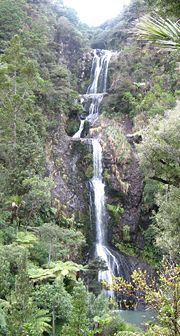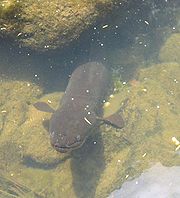
Kitekite Falls
Encyclopedia

Auckland
The Auckland metropolitan area , in the North Island of New Zealand, is the largest and most populous urban area in the country with residents, percent of the country's population. Auckland also has the largest Polynesian population of any city in the world...
, New Zealand
New Zealand
New Zealand is an island country in the south-western Pacific Ocean comprising two main landmasses and numerous smaller islands. The country is situated some east of Australia across the Tasman Sea, and roughly south of the Pacific island nations of New Caledonia, Fiji, and Tonga...
. The falls drop a total of 40 metres (131.2 ft). From the lookout on Kitekite track the falls appear even higher because there is white water running over rocks into a small pool from the upper swimming hole, then falling down into a large pool, then falling to a small pool before beginning an almost vertical descent in the final 3-tiers, making the total height closer to 80 metres (262.5 ft). They are located on the Glen Esk stream near Piha
Piha
Piha is a northern New Zealand coastal settlement with a population of about 600. It is one of the most popular beaches in the area and a major day-trip destination for Aucklanders throughout the year, although especially so in summer.-Location:...
Beach.
Kitekite Falls walk
From the carpark at the end of Glenesk Road, directions are clearly signposted. A well formed loop track, used by around 30,000 people a year (2005), follows the Glen Esk Stream with minor undulations (on the south side) up to a lookout where you find a huge Macrocarpa bench seat to rest on and admire the view. The bench seat was made by offenders doing community work (2005). The track then descends down wooden steps to the base of the falls (40 minutes from the carpark). The track then crosses the stream next to the lower swimming hole and returns down the north side. However, instead of going down again, a walker can climb a reasonably steep track (the Connect Track) which begins about 100m from the base of the falls on the northern side of the stream. It takes about 15 minutes to get to the top of the falls. There is a good swimming hole at the top although the water is cool. From this high vantage point there are great views down the valley.History
The area was milled for kauri from 1910-1921 until milling stopped. All the mature trees in the area were cut down. At the top of the falls, it is clear to see the notches in the rocks (rectangular cutouts for large pieces of wood to rest in). This was the location of the Glen Esk dam. The first attempt to drive logs down the falls resulted in their destruction on the rocks below and the dam was thereafter only used to flush the logs waiting in the stream below down to the mill. The remains of the heavy beams used can still be found in the stream today although they tend to move from time to time. In 2007 a beam fell, broke and half of it wedged itself into rocks at the base of the three tiered falls.Local flora and fauna

Agathis australis
Agathis australis, commonly known as the kauri, is a coniferous tree found north of 38°S in the northern districts of New Zealand's North Island. It is the largest but not tallest species of tree in New Zealand, standing up to 50 m tall in the emergent layer above the forest's main canopy. The...
), known as 'rickers' to regenerate and finally, begin to emerge through the forest canopy again. Many sharp pointed, cone shaped, rickers can be seen from the Kitekite loop track near the falls. At about 100 years old, kauri begin to develop a spreading crown. It is now approaching 100 years since milling stopped. The crowns generally continue to expand for a further 500 years.
The walk to the falls progresses through an impressive patch of nikau
Nikau
Nikau is a palm tree, the only palm endemic to New Zealand.-Etymology:Nīkau is a Māori word; in the closely related Eastern Polynesian languages of the tropical Pacific, it refers to the fronds or the midrib of the coconut palm.- Distribution:The Nikau palm is the only palm species endemic to...
palms where the call of the Tui (bird)
Tui (bird)
The tui is an endemic passerine bird of New Zealand. It is one of the largest members of the diverse honeyeater family....
is frequently heard from above. Other native plants include silver tree ferns, puriri
Puriri
Puriri is an evergreen tree endemic to New Zealand. -History:...
trees whose red berries attract kereru
Kereru
The New Zealand Pigeon or kererū is a bird endemic to New Zealand. Māori call it Kererū in most of the country but kūkupa and kūkū in some parts of the North Island, particularly in Northland...
(native pigeon), and the rangioroa plant (bushman's friend due the soft underside of its broad leaf). The falls have been identified as a site of a rare moss Fissidens rigidulus var. pseudostrictus.
New Zealand longfin eel
New Zealand longfin eel
The New Zealand Longfin eel is one of three freshwater eels found in New Zealand. The other two species of eel are the Shortfin eel which is also found in south-eastern Australia and the recently arrived Australian Longfin eel .The easiest method for identification of the New Zealand Longfin eel...
, (Anguilla dieffenbachii) hide among the rocks around the base of the falls.
Place names
'Kitekite' is a misspelling of the original name which was Kitakita. According to a Maori/English dictionary the word 'Kitakita' is defined as (stative) be bright (of colours), tightly, fast, intensely. Pronunciation of Kitakita:The 'i' in Maori is pronounced similar to the 'ee' in sleep.
'Glen Esk' stream was named by Dr William Stockwell. He emigrated to New Zealand in 1876 and bought land above Kitekite Falls soon after his arrival. He named the area 'Glen Esk' because it reminded him of his homeland in Scotland. 'Glen', from Gaelic, an Indo-European language spoken in Scotland (UK) and Ireland means 'valley'. 'Esk' is of Celtic origin and means 'water'.
Canyoning
The falls are used for canyoningCanyoning
Canyoning is traveling in canyons using a variety of techniques that may include other outdoor activities such as walking, scrambling, climbing, jumping, abseiling, and/or swimming....
by an Auckland Regional Parks licenced operator. The issuing of the licence was a 'hot issue' at the 2002 AGM of the Piha Ratepayers and Residents Association where residents voiced concern over the environmental impact to the Kitekite Falls. However, ARC recreation coordinator Lee Whiley said there were no concerns. This recreational activity continues to this day under close monitoring by council. Climbing on the falls (going off track) is strictly prohibited and can only be done with a permit or licenced guide. Restrictions are in place to protect the rare moss growing in the wet areas of the waterfall.

